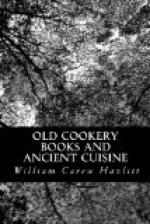“Ale and Spice, and Curdes and Creame,
Would make a Scholler make a Theame.”
Breton, in his “Fantasticks,” 1626, observes: “Milk, Butter and Cheese are the labourers dyet; and a pot of good Beer quickens his spirits.”
Norfolk dumplings were celebrated in John Day the playwright’s time. He has put into the mouth of his east-country yeoman’s son, Tom Strowd, in “The Blind Beggar of Bethnal Green,” written long before it was printed in 1659, the following:—“As God mend me, and ere thou com’st into Norfolk, I’ll give thee as good a dish of Norfolk dumplings as ere thou laydst thy lips to;” and in another passage of the same drama, where Swash’s shirt has been stolen, while he is in bed, he describes himself “as naked as your Norfolk dumplin.” In the play just quoted, Old Strowd, a Norfolk yeoman, speaks of his contentment with good beef, Norfolk bread, and country home-brewed drink; and in the “City Madam,” 1658, Holdfast tells us that before his master got an estate, “his family fed on roots and livers, and necks of beef on Sundays.” I cite these as traits of the kind of table kept by the lower grades of English society in the seventeenth century.
MEATS AND DRINKS.
Slender: You are afraid, if you see the bear loose, are you not?
Anne: Aye, indeed, Sir
Slender: That’s meat and drink to me, now.
MERRY WIVES OF WINDSOR, i, 1.
The manufacture of wine and of fruit preserves, and many of the processes of cookery, could have scarcely been accomplished without a large and constant supply of sugar.
The exact date of the first introduction of the latter into England continues to be a matter of uncertainty. It was clearly very scarce, and doubtless equally dear, when, in 1226, Henry III. asked the Mayor of Winchester to procure him three pounds of Alexandria sugar, if so much could be got, and also some rose and violet-coloured sugar; nor had it apparently grown much more plentiful when the same prince ordered the sheriffs of London to send him four loaves of sugar to Woodstock. But it soon made its way into the English homes, and before the end of the thirteenth century it could be procured even in remote provincial towns. It was sold either by the loaf or the pound. It was still exorbitantly high in price, varying from eighteen pence to three shillings a pound of coeval currency; and it was retailed by the spice-dealers.
In Russell’s “Book of Nurture,” composed about 1450, it occurs as an ingredient in hippocras; and one collects from a letter sent by Sir Edward Wotton to Lord Cobham from Calais in 1546, that at that time the quantities imported were larger, and the price reduced; for Wotton advises his correspondent of a consignment of five-and-twenty loaves at six shillings the loaf. One loaf was equal to ten pounds; this brought the commodity down to eight pence a pound of fifteenth century money.




